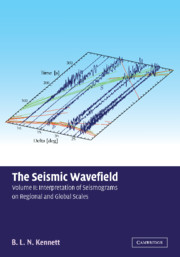Book contents
- Frontmatter
- Contents
- Preface to Volume II
- Part III Local and Regional Events
- 17 Near Events
- 18 Propagation Effects at Near Distances
- 19 Regional Phases I - Propagation in the Crust and Uppermost Mantle
- 20 Regional Phases II - The Influence of Structure
- 21 Propagation in the Upper Mantle
- 22 Upper Mantle Structure
- 23 Analysis of Regional and Far-Regional Seismograms
- Part IV Global Wave Propagation
- Part V The Three-dimensional Earth
- Appendix Paths and Travel times
- Bibliography
- Index
23 - Analysis of Regional and Far-Regional Seismograms
from Part III - Local and Regional Events
Published online by Cambridge University Press: 31 August 2019
- Frontmatter
- Contents
- Preface to Volume II
- Part III Local and Regional Events
- 17 Near Events
- 18 Propagation Effects at Near Distances
- 19 Regional Phases I - Propagation in the Crust and Uppermost Mantle
- 20 Regional Phases II - The Influence of Structure
- 21 Propagation in the Upper Mantle
- 22 Upper Mantle Structure
- 23 Analysis of Regional and Far-Regional Seismograms
- Part IV Global Wave Propagation
- Part V The Three-dimensional Earth
- Appendix Paths and Travel times
- Bibliography
- Index
Summary
There is considerable variety in the ways in which events at regional distances are treated in different parts of the world. Most seismically active regions have a well distributed set of stations across the zone where earthquakes are most common, and the tendency in recent years has been for higher concentrations of instrumentation as, e.g., in Southern California and Japan. Where there are a significant number of seismic stations an indication of the likely position of an event is provided by the station recording the first indications of ground motion. This helps to start the process of location which is usually accomplished by a linearised inversion scheme or using some grid search algorithm (see Section 29.1). With relatively close stations it is usually possible to get quite good constraints of the depth of the event by exploiting both P and S information, using a velocity model designed to fit local conditions. The major difficulties in tectonically active areas come with the presence of substantial 3-D structure which introduces systematic errors into simple location procedures. It is frequently difficult to be confident of the association of smaller events with mapped faults.
For the San Andreas fault in central California, the marked contrast in seismic properties between the two sides of the transcurrent fault makes precise location difficult. There appears to be an offset between events at depth and the surface trace of the fault (Thurber et al., 2000) and this has been one facet of efforts to set up an observatory system with drilling through the fault zone at depth (the SAFOD project). Seismometers down the drill hole are planned to allow close observations of small magnitude events and so pin down the region where slip is occurring on this major fault.
In less seismically active areas the networks of stations tend to be rather sparse, so that there is both poorer coverage of events and poorer location capability. Also there are frequently more man-made events, e.g., from quarrying or mining which can be picked up using the networks. Even in such areas the majority of analysis is based on using short-period records for single stations.
- Type
- Chapter
- Information
- The Seismic WavefieldVolume II: Interpretation of Seismograms on Regional and Global Scales, pp. 163 - 186Publisher: Cambridge University PressPrint publication year: 2002



